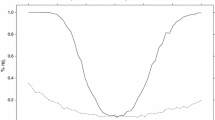Abstract
The model misspecification effects on the maximum likelihood estimator are studied when a biased sample is treated as a random one as well as when a random sample is treated as a biased one. The relation between the existence of a consistent estimator under model misspecification and the completeness of the distribution is also considered. The cases of the weight invariant distribution and the scale parameter distribution are examined and finally an example is presented to illustrate the results.
Similar content being viewed by others
References
Abramowitz M, Stegun A (1970) Handbook of mathematical functions. Dover, New York
Bai J, Jakeman AJ, McAleer M (1992) Estimating the percentiles of some misspecified non-nested distributions. J Stat Comput Simul 42:151–159
Bickel JP, Doksum AK (2001) Mathematical statistics: basic ideas and selected topics, 2nd edn. Prentice Hall, New Jersey
Blumenthal S (1966) Proportional sampling in life length studies. Technometrics 9(2):205–218
Fokianos K, Kaimi I (2006) On the effects of misspecifying the density ratio model. Inst Stat Math 58:475–497
Gove JH (2003) Moment and maximum likelihood estimators for weibull distributions under length- and area biased sampling. Environ Ecol Stat 10:455–467
Huber P (1967) The behavior of the maximum likelihood estimates under nonstandard conditions. Proceedings of the Fifth Berkeley Symposium on Mathematical Statistics and Probability, vol 1, University of California Press, Berkeley, pp 221–233
Jiang W, Turnbull B (2004) The indirect method: inference based on intermediate statistics- a synthesis and examples. Stat Sci 19(2):239–263
Knight K (2000) Mathematical statistics. Chapman & Hall, Boca Raton
Lemonte JA (2013) On the gradient statistic under model misspecification. Stat Probab Lett 83:390–398
Lv J, Liu JS (2014) Model selection principles in misspecified models. J R Stat Soc Ser B 76(1):141–167
Morimoto T, Nakagawa S, Shinji S (2005) Bias in the weibull strength estimation of a sic fiber for the small gauge length case. JSME Int Ser A 48(4):194–198
Pascual GF (2005) Maximum likelihood estimation under misspecified lognormal and weibull distributions. Commun Stat-Simul Comput 34:503–524
Patil GP (2002) Weighted distributions. In: Encyclopedia of environmetrics, Wiley, Chichester, pp 2369–2377
Patil G, Ord J (1976) On size-biased sampling and related form invariant weighted distributions. Sankhya Ser B 38:48–61
Patil GP, Rao CR (1978) Weighted distributions and size-biased sampling with applications to wildlife populations and human families. Biometrics 34(2):179–189
Scheaffer RL (1972) Size-biased sampling. Technometrics 14(3):635–644
Sharma AK (2004) Text book for analysis-II. Discovery Publishing Pvt. Ltd, New Delhi
White H (1982) Maximum likelihood estimation in misspecified models. Econometrica 50(1):1–25
Yi G, Reid N (2010) A note on misspecified estimating functions. Stat Sin 20:1749–1769
Yu HF (2007) Mis-specification analysis bewteen normal and extreme value distributions for a linear regression model. Commun Stat-Theory Methods 36:499–521
Acknowledgments
The authors are most grateful to the anonymous referee and the Assosiate Editor for careful reading of the manuscript and valuable suggestions which helped to improve an earlier version of this paper.
Author information
Authors and Affiliations
Corresponding author
Appendix
Appendix
Proof of Lemma 1
For x sufficiently large we have
and since \(\int _0^{\infty }f(t)dt\,{<}\,\infty \) from the Cauchy criterion for proper integrals (Sharma 2004) we obtain \(\lim \nolimits _{x \rightarrow \infty } xf(x)<2\lim \nolimits _{x \rightarrow \infty } \int \nolimits _{x/2}^{x}f(t)dt =0\).
The same argument holds when \(x \,{\rightarrow }\, 0+\). If f is locally increasing and thus bounded in a neighborhood of \(x_0\,{=}\,0\), the result is trivial. If f is locally decreasing then for x close to 0 we obtain
from which the result follows trivially for \(x \,{\rightarrow }\, 0+\). \(\square \)
Rights and permissions
About this article
Cite this article
Tzavelas, G., Douli, M. & Economou, P. Model misspecification effects for biased samples. Metrika 80, 171–185 (2017). https://doi.org/10.1007/s00184-016-0597-5
Received:
Published:
Issue Date:
DOI: https://doi.org/10.1007/s00184-016-0597-5




